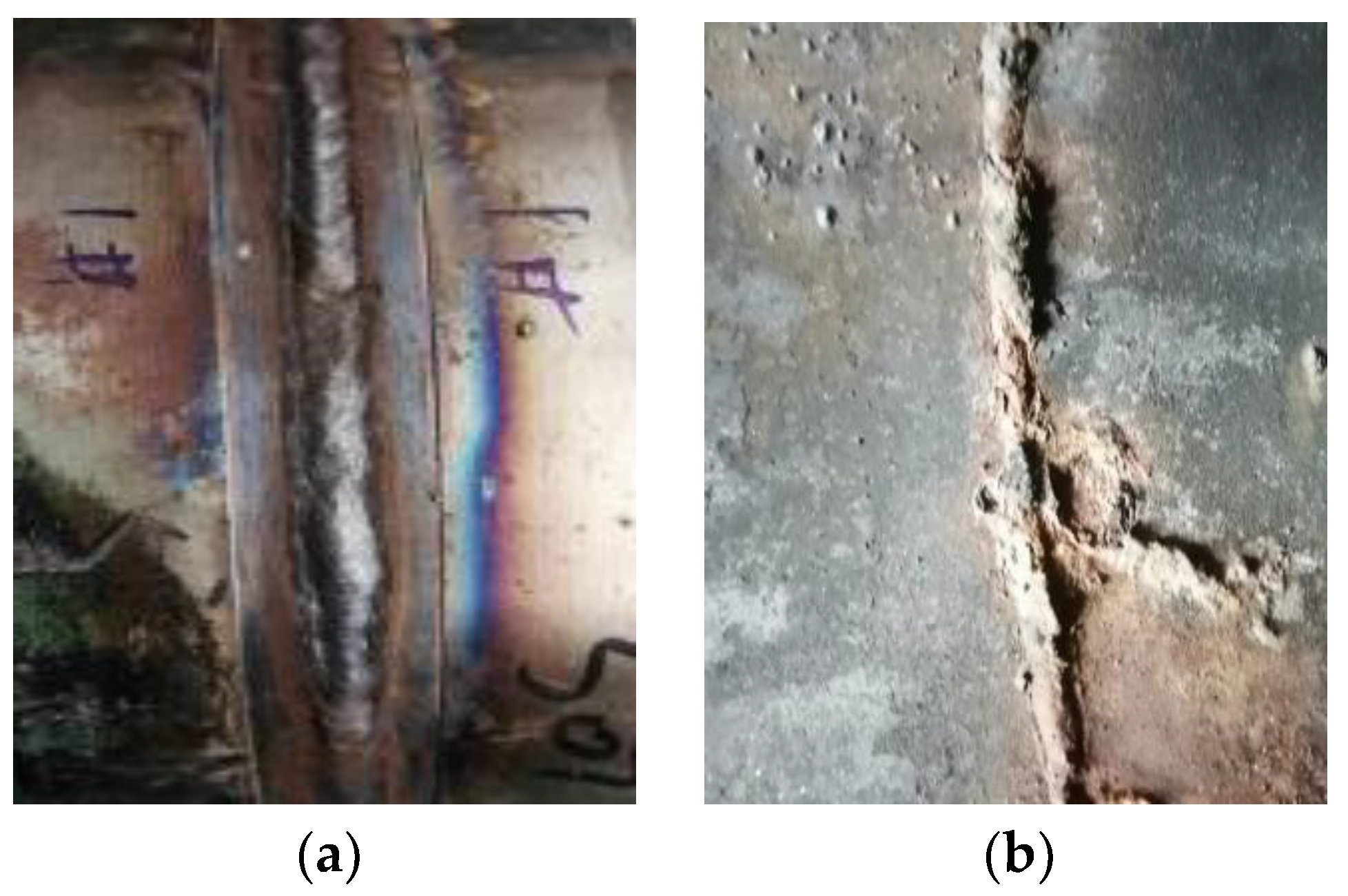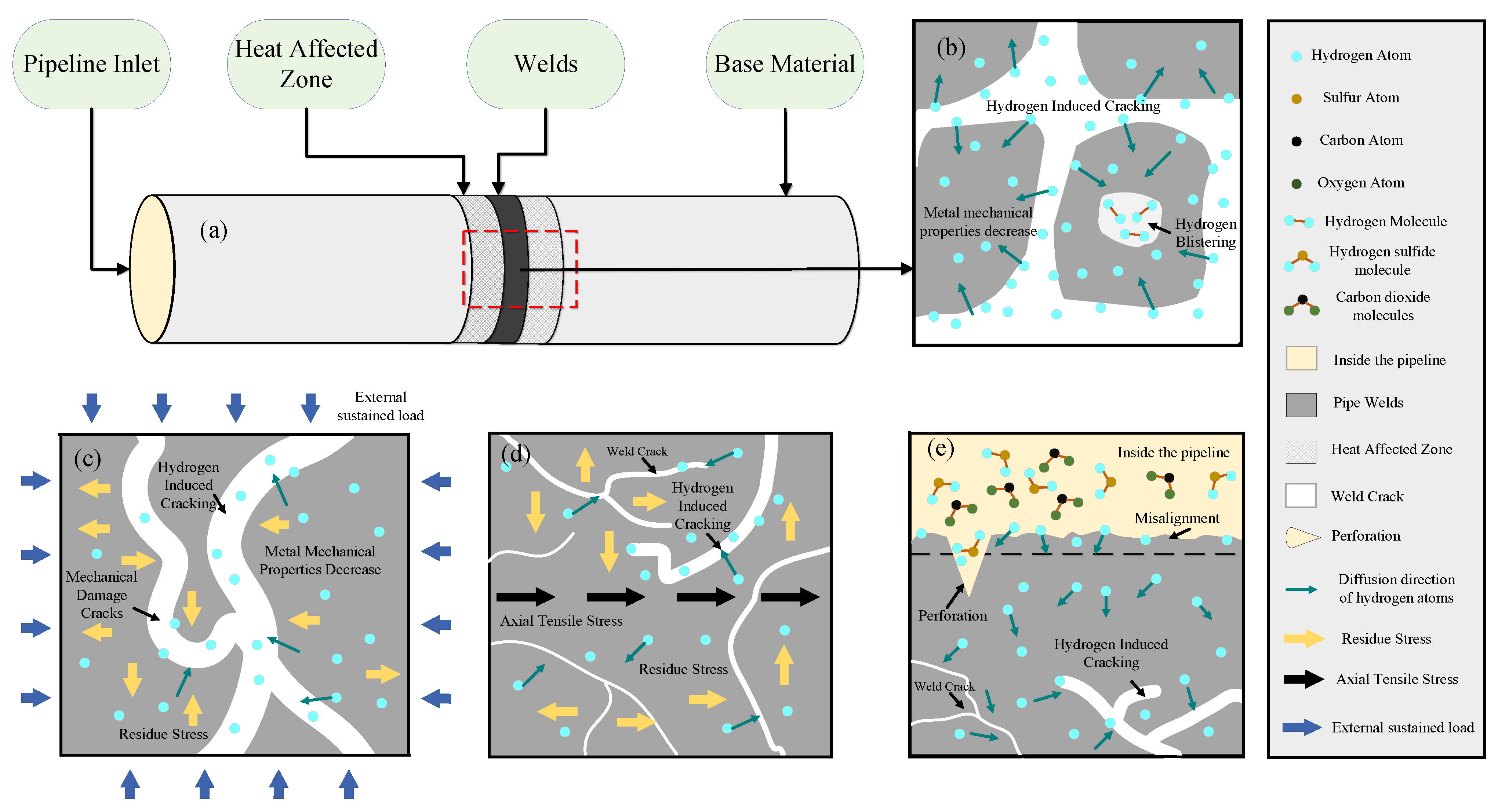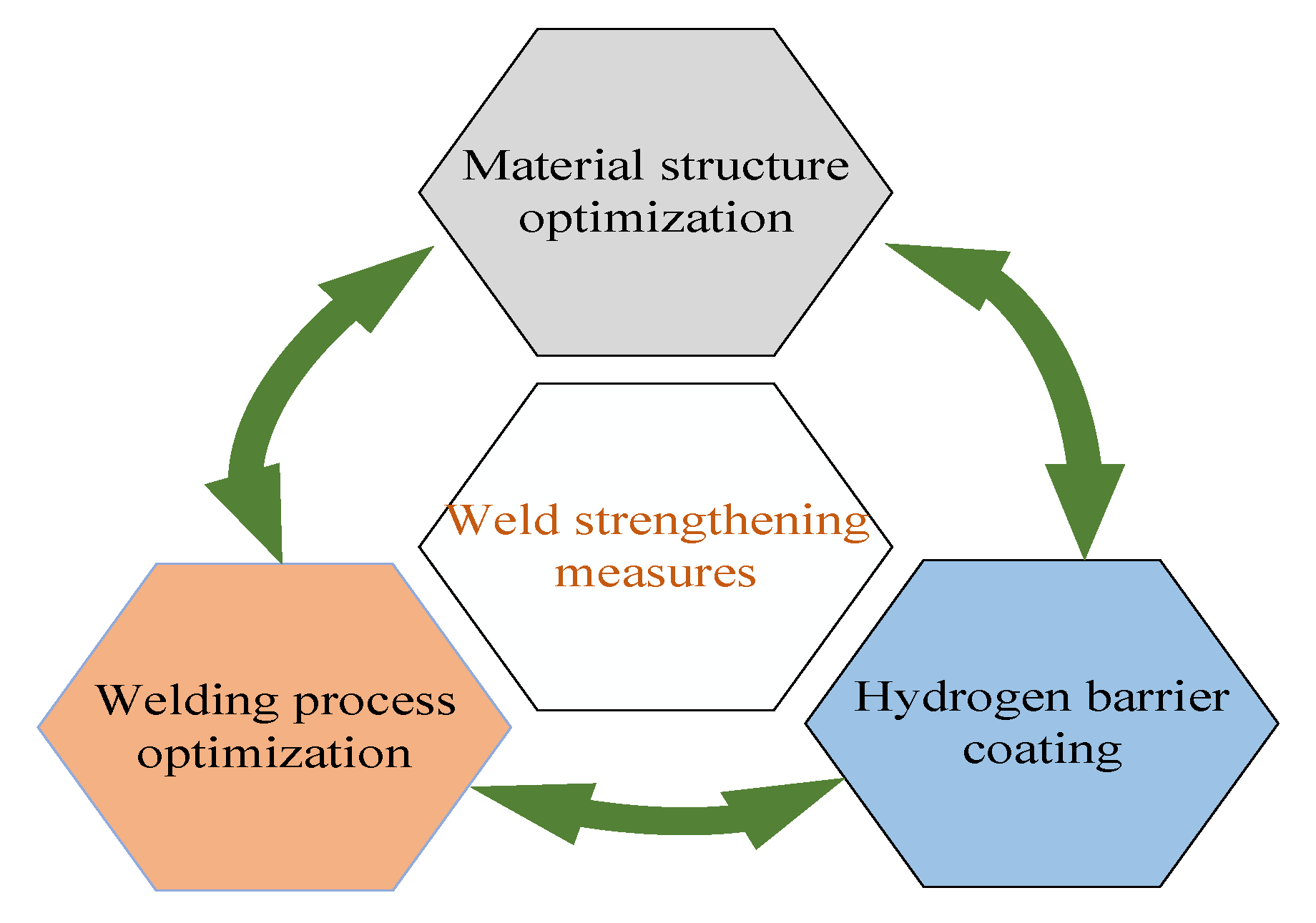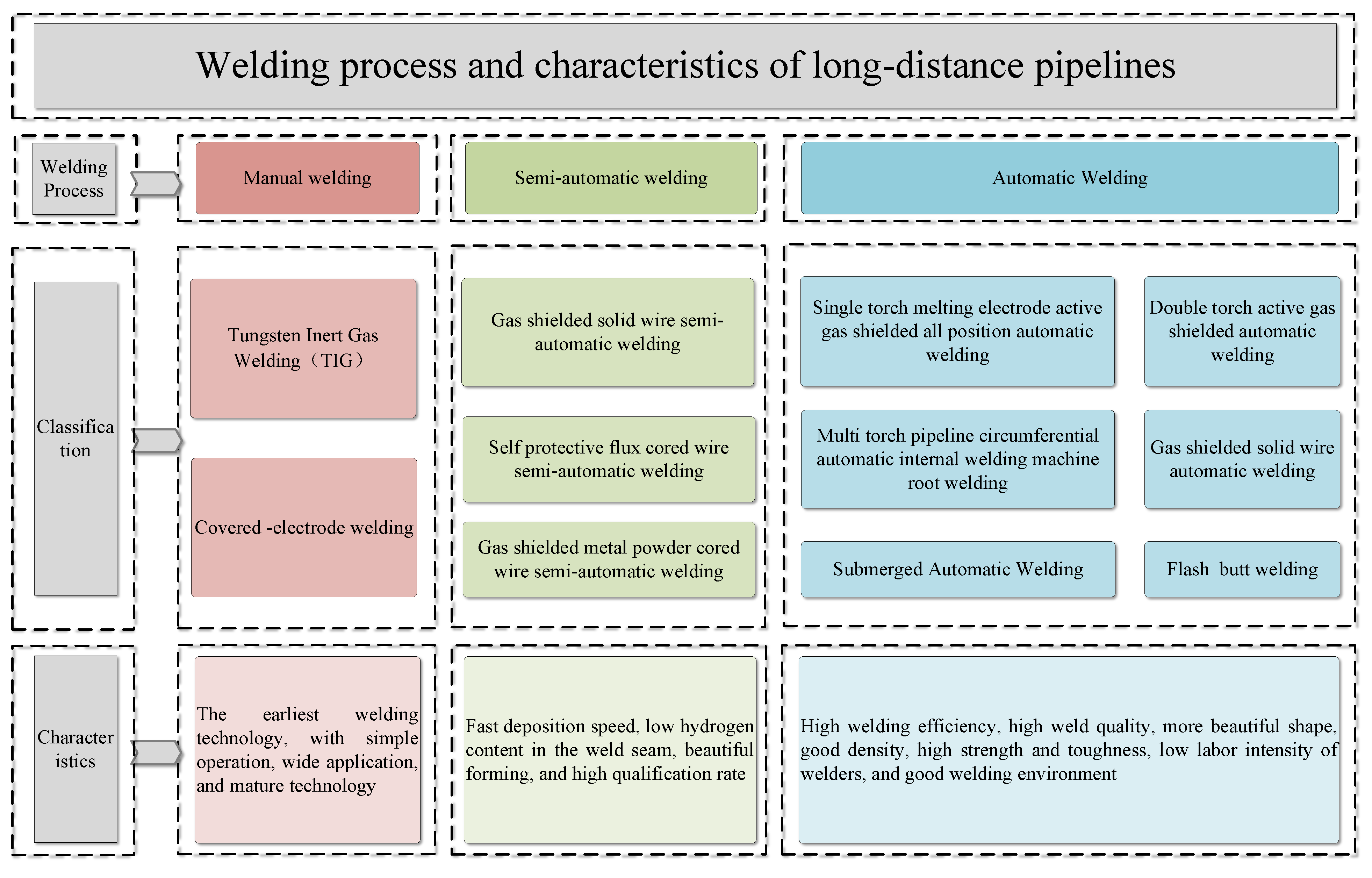Research Progress and Prospects on Hydrogen Damage in Welds of Hydrogen-Blended Natural Gas Pipelines
Abstract
:1. Introduction
2. Characteristics of Weld Seam of Hydrogen-Doped Natural Gas Pipeline
3. Hydrogen Damage Mechanism of Hydrogen-Doped Natural Gas Pipeline Weld
3.1. Hydrogen Damage Mechanism of Pipeline Weld
3.2. Mechanical Damage Mechanism of Hydrogen Damage Superposition of Pipeline Welds
3.3. Brittle Fracture Mechanism of Hydrogen Damage Superimposed on Pipeline Weld
3.4. Hydrogen Damage Superimposed Corrosion Damage Mechanism of Pipeline Welds
4. Strengthening the Mechanical Properties of Weld Seam of Hydrogen-Doped Natural Gas Pipeline
4.1. Pipeline Material Structure Optimization
4.2. Welding Process Optimization
4.3. Hydrogen-Resistant Coating for Pipeline Welds
5. Summary and Prospect
Funding
Data Availability Statement
Conflicts of Interest
References
- Liu, J.; Zhong, C. Current Status and Prospects of Hydrogen Energy Development in China. Energy China 2019, 41, 32–36. [Google Scholar]
- Zou, C.; Xiong, B.; Xue, H.; Zheng, D.; Ge, Z.; Wang, Y.; Jiang, L.; Pan, S.; Wu, S. The role of new energy in carbon neutral. Pet. Explor. Dev. 2021, 48, 480–491. [Google Scholar] [CrossRef]
- Liu, W.; Wan, Y.; Xiong, Y.; Liu, J. Outlook of low carbon and clean hydrogen in China under the goal of carbon peak and neutrality. Energy Storage Sci. Technol. 2022, 11, 635–642. [Google Scholar]
- Liu, C.; Pei, Y.; Han, H.; Zhou, H.; Zhang, R.; Li, Y.; Zhu, J.; Wang, C.; Kong, Y. Research status and development trend of hydrogen energy industry chain and the storage and transportation technologies. Oil Gas Storage Transp. 2022, 41, 498–514. [Google Scholar]
- Meng, X.; Chen, M.; Gu, A.; Wu, X.; Liu, B.; Zhou, J.; Mao, Z. Research status and development trend of hydrogen energy industry chain and the storage and transportation technologies. Nat. Gas Ind. 2022, 42, 156–179. [Google Scholar]
- Dai, H.; Su, Y.; Liu, J.; Gu, D.; Kuang, L.; Zou, C. Thinking of China’s Energy Development Strategy under Carbon Neutrality Goal. Pet. Sci. Technol. Forum 2022, 41, 1–8. [Google Scholar]
- Jiang, Q.; Wang, Q.; Xie, P.; Qu, X. Development Status and Analysis of Long- distance Hydrogen Pipeline at Home and Abroad. Oil-Gas Field Surf. Eng. 2019, 38, 6–8. [Google Scholar]
- Li, J.; Su, Y.; Zhang, H.; Yu, B. Research progresses on pipeline transportation of hydrogen-blended natural gas. Nat. Gas Ind. 2021, 41, 137–152. [Google Scholar]
- Zhang, C.; Shao, Y.; Shen, W.; Li, H.; Nan, Z.; Dong, M.; Bian, J.; Cao, X. Key Technologies of Pure Hydrogen and Hydrogen-Mixed Natural Gas Pipeline Transportation. ACS Omega 2023, 8, 19212–19222. [Google Scholar] [CrossRef]
- Qiu, Y.; Zhou, S.; Chen, J.; Wu, Z.; Hong, Q. Hydrogen-Enriched Compressed Natural Gas Network Simulation for Consuming Green Hydrogen Considering the Hydrogen Diffusion Process. Processes 2022, 10, 1757. [Google Scholar] [CrossRef]
- Ren, R.; You, S.; Zhu, X.; Yue, X.; Jiang, Z. Development Status and Prospects of Hydrogen Compressed Natural Gas Transportation Technology gen-blended natural gas. Pet. New Energy 2021, 33, 26–32. [Google Scholar]
- Zou, K. Technical Characteristics of Japan’s Hydrogen Gas Turbine. Dongfang Turbine 2022, 4, 1–5+15, ISSN 1674-9987. [Google Scholar]
- Florisson, O. DNV GL project urges natural gas industry to be ready for hydrogen. Fuel Cells Bull. 2015, 2015, 9. [Google Scholar]
- HyDeploy under way as UK’s grid-injection hydrogen pilot project. Fuel Cells Bull. 2020, 2020, 10.
- GRHYD project inaugurates first P2G demonstrator in France. Fuel Cells Bull. 2018, 2018, 9–10.
- Zhang, J.; Wang, C.; Liu, C.; Hu, Q.; Zhang, R.; Xu, X.; Ju, S.; Li, Y. Research progresses on pipeline transportation of hydrogen-blended natural gas. Surf. Technol. 2022, 51, 76–88. [Google Scholar]
- Salzgitter Flachstahl, Linde in steel industry clean hydrogen project. Fuel Cells Bull. 2018, 2018, 12. [CrossRef]
- Zhong, B.; Zhang, X.; Zhang, B.; Peng, S. Industrial Development of Hydrogen Blending in Natural Gas Pipelines in China. Strateg. Study Chin. Acad. Eng. 2022, 24, 100–107. [Google Scholar] [CrossRef]
- Zhang, Q.; Huang, X. Analysis of domestic and foreign hydrogen energy industrial policies and technical economy. Low-Carbon Chem. Chem. Eng. 2023, 48, 133–139. [Google Scholar]
- Wang, G.; Li, C.; Jia, W. Study on adaptability of standard orifice plate flowmeter for hydrogen-mixed natural gas pipeline. Chem. Eng. Oil Gas 2022, 51, 101–106. [Google Scholar]
- Zhou, J. Characteristic Analysis of Mixing Hydrogen in Natural Gas Pipeline. Master’s Thesis, LiaoNing Petrochemical University, Fushun, China, 2020. [Google Scholar]
- Shang, J.; Lu, Y.; Zheng, J.; Chen, S.; Hua, Z.; Yu, W.; Zhang, Y. Research status-in-situ and key challenges in pipeline transportation of hydrogen-natural gas mixtures. Chem. Ind. Eng. Prog. 2021, 40, 5499–5505. [Google Scholar]
- Zhao, Y.; Zhang, X.; Zheng, J.; Gu, C.; Zhang, L. Hydrogen Doped Natural Gas Pipeline Transportation Safety Technology. Chem. Eng. Mach. 2016, 43, 1–7. [Google Scholar]
- Cheng, Y. Essence and gap analysis for hydrogen embrittlement of pipelines in high-pressure hydrogen environments. Oil Gas Storage Transp. 2023, 42, 1–8. [Google Scholar]
- Ping, X.; Wu, Y.; Li, C.; Jia, W.; Zhang, H.; Wu, X. Research progress on pipeline transportation technology of hydrogenmixed natural gas. Oil Gas Storage Transp. 2021, 40, 361–370. [Google Scholar]
- Reitenbach, V.; Ganzer, L.; Albrecht, D.; Hagemann, B. Influence of added hydrogen on underground gas storage: A review of key issues. Environ. Earth Sci. 2015, 73, 6927–6937. [Google Scholar] [CrossRef]
- Yan, S.; Zhou, D. Review of Simulation and Scheduling of Hydrogen-blended Transportation in Natural Gas Network of Integrated Energy System. Proc. CSEE 2022, 42, 8816–8832. [Google Scholar]
- Zhang, H. Numerical Simulation Study on Hydro-Thermal Characteristics and Mechanical Properties of Pipeline for the Transportation of Natuaral Gas-Hydrogen Mixtures; Beijing Institute of Petrochemical Technology: Beijing, China, 2021. [Google Scholar]
- Yin, C.; Gao, Z.; Xue, Z. Welding process present and prospect of long-distance transport pipeline. Electr. Weld. Mach. 2013, 43, 134–141. [Google Scholar]
- Huang, G.; Zheng, J.Y.; Meng, B.; Hua, Z.L.; Lu, Q.J.; Li, X.Y.; Xu, P. Mechanical Properties of X70 welded joint in high-pressure natural gas/hydrogen mixtures. J. Mater. Eng. Perform. 2020, 29, 1589–1599. [Google Scholar] [CrossRef]
- Fangnon, E.; Yagodzinskyy, Y.; Malictki, E.; Mehtonen, S.; Virolainen, E.; Vilaça, P. Determination of Critical Hydrogen Concentration and Its Effect on Mechanical Performance of 2200 MPa and 600 HBW Martensitic Ultra-High-Strength Steel. Metals 2021, 11, 984. [Google Scholar] [CrossRef]
- Zheng, J.Y.; Liu, X.X.; Xu, P.; Liu, P.F.; Zhao, Y.Z.; Yang, J. Development of high pressure gaseous hydrogen storage technologies. Int. J. Hydrogen Energy 2012, 37, 1048–1057. [Google Scholar] [CrossRef]
- Nagumo, M.; Takai, K. The predominant role of strain-induced vacancies in hydrogen embrittlement of steels: Overview. Acta Mater. 2018, 165, 722–733. [Google Scholar] [CrossRef]
- Kane, M.C. Permeability, Solubility, and Interaction of Hydrogen in Polymers-An Assessment of Materials for Hydrogen Transport: WSRC-STI-2008-00009; Savannah River Site: Aiken, SC, USA, 2008; pp. 4–6. [Google Scholar]
- Troiano, A.R. The role of hydrogen and other interstitials in the mechanical behavior of metals. Metallogr. Microstruct. Anal. 2016, 5, 557–569. [Google Scholar] [CrossRef]
- Dadfarnia, M.; Novak, P.; Ahn, D.C.; Liu, J.B.; Sofronis, P.; Johnson, D.D.; Robertson, I.M. Recent Advances in the Study of Structural Materials Compatibility with Hydrogen. Adv. Mater. 2010, 22, 1128–1135. [Google Scholar] [CrossRef] [PubMed]
- Lynch, S. Hydrogen embrittlement (HE) phenomena and mechanisms. Stress Corros. Crack. 2011, 30, 90–130. [Google Scholar]
- Yousuf, S.; Enoch, I. Hydrogen embrittlement phenomena and mechanisms. Corros. Rev. 2012, 30, 105–123. [Google Scholar]
- Djukic, M.B.; Bakic, G.M.; Zeravcic, V.S.; Sedmak, A.; Rajicic, B. The synergistic action and interplay of hydrogen embrittlement mechanisms in steels and iron: Localized plasticity and decohesion. Eng. Fract. Mech. 2019, 216, 106528. [Google Scholar] [CrossRef]
- Xie, D.; Li, S.; Li, M.; Wang, Z.; Gumbsch, P.; Sun, J.; Ma, E.; Li, J.; Shan, Z. Hydrogenated vacancies lock dislocations in aluminium. Nat. Commun. 2016, 7, 13341. [Google Scholar] [CrossRef]
- Martin, M.L.; Dadfarnia, M.; Nagao, A.; Wang, S.; Sofronis, P. Enumeration of the hydrogen-enhanced localized plasticity mechanism for hydrogen embrittlement instructural materials. Acta Mater. 2019, 165, 734–750. [Google Scholar] [CrossRef]
- Sezgin, J.-G.; Bosch, C.; Montouchet, A.; Perrin, G.; Wolski, K. Modelling of hydrogen induced pressurization of internal cavities. Int. J. Hydrogen Energy 2017, 42, 15403–15414. [Google Scholar] [CrossRef]
- Huang, S.; Chen, D.K.; Song, J.; Mcdowell, D.L.; Zhu, T. Hydrogen embrittlement of grain boundaries in nickel: An atomistic study. NPJ Comput. Mater. 2017, 3, 28. [Google Scholar] [CrossRef]
- Zhang, T.; Zhao, W.; Jiang, W.; Wang, Y.; Yang, M. Numerical Simulation of Hydrogen Diffusion in X80 Welded Joint Under the Combined Effect of Residual Stress and Microstructure Inhomogeneity. Acta Metall. Sin. 2019, 55, 258–266. [Google Scholar]
- Alvaro, A.; Olden, V.; Macadre, A.; Akselsen, O.M. Hydrogen embrittlement susceptibility of a weld simulated X70 heat affected zone under H2 pressure. Mater. Sci. Eng. A 2014, 597, 29e36. [Google Scholar] [CrossRef]
- Sun, Y.; Cheng, Y.F. Hydrogen permeation and distribution at a high-strength X80 steel weld under stressing conditions and the implication on pipeline failure. Int. J. Hydrogen Energy 2021, 46, 23100e12. [Google Scholar] [CrossRef]
- Gou, J.; Nie, R.; Xing, X.; Li, Z.; Cui, G.; Liu, J.; Deng, X.; Cheng, Y.F. Hydrogen-induced cracking of welded X80 steel studies by experimental testing and molecular dynamics modeling. Corros. Sci. 2023, 214, 111027. [Google Scholar] [CrossRef]
- Cui, W.; Xiao, Z.; Zhang, Q.; Yang, J.; Feng, Z. Modeling the Crack Interference in X80 Oil and Gas Pipeline Weld. Materials 2023, 16, 3330. [Google Scholar] [CrossRef] [PubMed]
- Li, L.; Qin, X.; Wang, S.; Chang, D.W. Failure Analysis of Girth Weld Cracking of a Pipeline. Hot Work. Technol. 2019, 48, 259–262. [Google Scholar]
- Yang, F.; Cheng, F.; Zhang, H.; Wang, G.; Zhang, L.; Jia, P. Failure Case and Full Scale Test of Oil and Gas Pipeline Girth Weld. Pet. Tubul. Goods Instrum. 2022, 8, 80–84. [Google Scholar]
- Yang, F.; Zou, B.; Zhang, W.; Zhu, J.; Cao, G. Research on semi-automatic circumferential weld failure assessment technology for high steel grade pipelines. Pet. Tubul. Goods Instrum. 2021, 7, 35–44. [Google Scholar]
- Jing, J. Analysis of Weld Crack Failure of Large Diameter Stainless Steel Pipe. Chem. Pharm. Eng. 2019, 40, 43–49. [Google Scholar]
- Tuz, L. Evaluation of the Microstructure and Mechanical Properties of the Butt-Welded Joints of Spiral Pipes Made of L485ME (X70) Steel. Materials 2023, 16, 6557. [Google Scholar] [CrossRef]
- Li, Y.; Du, Z.; Tao, Y.; Li, J. Sulfide stress cracking of X70pipeline steels. Trans. China Weld. 2003, 3, 76–78. [Google Scholar]
- Anijdan, S.H.; Sabzi, M.; Park, N.; Lee, U. Sour corrosion performance and sensitivity to hydrogen induced cracking in the X70 pipeline steel: Effect of microstructural variation and pearlite percentage. Int. J. Press. Vessel. Pip. 2022, 199, 104759. [Google Scholar] [CrossRef]
- Wu, X.; Zhang, H.; Yang, M.; Jia, W.; Qiu, Y.; Lan, L. From the perspective of new technology of blending hydrogen into natural gas pipelines transmission: Mechanism, experimental study, and suggestions for further work of hydrogen embrittlement in high-strength pipeline steels. Int. J. Hydrogen Energy 2022, 47, 8071–8090. [Google Scholar] [CrossRef]
- Al-Mansour, M.; Alfantazi, A.; El-Boujdaini, M. Sulfide stress cracking resistance of API-X100 high strength low alloy steel. Mater. Des. 2009, 30, 4088–4094. [Google Scholar] [CrossRef]
- Nanninga, N.; Levy, Y.S.; Drexler, E.S.; Condon, R.T.; Stevenson, A.E.; Slifka, A.J. Comparison of hydrogen embrittlement in three pipeline steels in high pressure gaseous hydrogen environments. Corros. Sci. 2012, 59, 1–9. [Google Scholar] [CrossRef]
- Capelle, J.; Gilgert, J.; Dmytrakh, I.; Pluvinage, G. Sensitivity of pipelines with steel API X52 to hydrogen embrittlement. Int. J. Hydrogen Energy 2008, 33, 7630–7641. [Google Scholar] [CrossRef]
- Liu, C.; Yang, H.; Wang, C.; Zhang, H.; Ding, R.; Ai, L.; Fan, X.; Zhang, R.; Xu, X.; Ning, Y.; et al. Effects of CH4 and CO on hydrogen embrittlement susceptibility of X80 pipeline steel in hydrogen blended natural gas. Int. J. Hydrogen Energy 2023, 48, 27766–27777. [Google Scholar] [CrossRef]
- Wang, D.; Tan, Q.; Yang, J.; Huang, D. New type of high-strength flexible cover plate to prevent engineering failure in oil and gas pipeline engineering. Eng. Fail. Anal. 2022, 139, 106477. [Google Scholar] [CrossRef]
- WZhang, W.J.; Cross, I.; Feldman, P.; Rama, S.; Norman, S.; Del Duca, M. Electrode life of aluminium resistance spot welding in automotive applications: A survey. Sci. Technol. Weld. Join. 2016, 22, 22–40. [Google Scholar] [CrossRef]
- Gould, J.E. Joining aluminum sheet in the automotive industry—A 30-year history. Weld. J. 2012, 91, 23–34. [Google Scholar]
- Bachchhav, B.; Bharne, S.; Choudhari, A.; Pattanshetti, S. Selection of spot welding electrode material by AHP, TOPSIS, and SAW. Mater. Today Proc. 2023. [Google Scholar] [CrossRef]
- Chen, Y.; Zhang, L.; Fu, G. Experimental Research on Weld Seam Failure of CO2 Gas Field Gathering Pipeline. West. Spec. Equip. 2022, 5, 64–71. [Google Scholar]
- Jiang, X.; Ai, F.; Wu, H. Effect of welding alloying on microstructure and corrosion resistance of carbon steel welded joints. Chem. Eng. Oil Gas 2022, 51, 75–79. [Google Scholar]
- Singaravel, B.; Chakradhar, B.; Rajan, D.S.; Kumar, A.K. Optimization of friction stir welding process parameters using MCDM method. Mater. Today Proc. 2023, 76, 597–601. [Google Scholar] [CrossRef]
- Verma, R.P.; Pandey, K.; András, K.; Khargotra, R.; Singh, T. Difficulties and redressal in joining of aluminium alloys by GMA and GTA welding: A review. J. Mater. Res. Technol. 2023, 23, 2576–2586. [Google Scholar] [CrossRef]
- Gu, Y.; Li, Z.; Li, J.; Wang, Q.; Zhao, Y.; Wu, C.; Su, X.; Peng, H. Effect of Ti addition on mechanical properties and corrosion resistance of X80 pipeline steel. Int. J. Press. Vessel. Pip. 2023, 206, 105003. [Google Scholar] [CrossRef]
- Xia, F.; Li, Z.; Ma, M.; Zhao, Y.; Wu, C.; Su, X.; Peng, H. Effect of Nb on microstructure and corrosion resistance of X80 pipeline steel. Int. J. Press. Vessel. Pip. 2023, 203, 104949. [Google Scholar] [CrossRef]
- Zhao, Y.; Zhu, Z.; Zhao, X.; Tian, R.; Lei, Y.; Yu, P.; Peng, H.; Chen, L. Clarify the effect of reversed austenite on the pitting corrosion resistance of super 13Cr martensitic stainless steel. Corros. Sci. 2023, 213, 110992. [Google Scholar] [CrossRef]
- Chen, J.; Tang, X.; Chen, Q.; Tao, K.; Shen, G.; Li, T. Study on the impact of hydrogen-blended natural gas on process safety of pipeline transmission. Nat. Gas Oil 2022, 40, 16–22. [Google Scholar]
- ASME B31.12-2014; Hydrogen Piping and Pipelines. ASME: New York, NY, USA, 2014.
- Zhong, G.; Xi, X. Design Key Points of Hydrogen Pipelines. Welded Pipe Tube 2023, 46, 59–64. [Google Scholar]
- ANSI/AIAA G-095-2004; Guide to Safety of Hydrogen and Hydrogen Systems. NASA: Washington, DC, USA, 2004.
- Kagomiya, I.; Sugiyama, Y.; Kakimoto, K.-I. Preparation and hydrogen permeation properties of Pd–Al2O3 matrix composites. J. Ceram. Soc. Jpn. 2018, 126, 573–578. [Google Scholar] [CrossRef]
- IIsobe, K.; Yamanishi, T.; Konishi, S. Tritium permeation behavior in SiC/SiC composites. Fusion Eng. Des. 2010, 85, 1012–1015. [Google Scholar] [CrossRef]
- Feng, S.J.; Wang, Y.; Zhang, C.; Luo, C.L.; Xu, J.X.; Suo, J.P. Preparation of Al2O3/Cr2O3 tritium permeation barrier with combination of pack cementation and sol-gel methods. Fusion Eng. Des. 2018, 131, 1–7. [Google Scholar] [CrossRef]
- Zhou, P.W.; Li, W.; Jin, X.J. Electrochemical hydrogen permeation properties of MoS2 and Ni80Cr20 films prepared by magnetron sputtering on pure iron. J. Electrochem. Soc. 2018, 165, 256–261. [Google Scholar] [CrossRef]
- Ke, N.; Huang, H.; Wang, F.; Dong, B.; Huang, A.; Hao, L.; Xu, X. Study on the hydrogen barrier performance of the SiOC coating. Int. J. Hydrogen Energy 2023, 48, 8286–8295. [Google Scholar] [CrossRef]
- Yuan, S.; Sun, Y.; Cong, C.; Liu, Y.; Lin, D.; Pei, L.; Zhu, Y.; Wang, H. A bi-layer orientated and functionalized graphene-based composite coating with unique hydrogen gas barrier and long-term anti-corrosion performance. Carbon 2023, 205, 54–68. [Google Scholar] [CrossRef]
- Shi, K.; Xiao, S.; Ruan, Q.; Wu, H.; Chen, G.; Zhou, C.; Jiang, S.; Xi, K.; He, M.; Chu, P.K. Hydrogen permeation behavior and mechanism of multi-layered graphene coatings and mitigation of hydrogen embrittlement of pipe steel. Appl. Surf. Sci. 2022, 573, 151529. [Google Scholar] [CrossRef]
- Shojaeinia, A.; Aghajani, H.; Tabrizi, A.T. Evaluation of electrochemical hydrogen storage capability of graphene oxide multi-layer coating. Int. J. Hydrogen Energy 2023, 48, 5836–5849. [Google Scholar] [CrossRef]
- Gang, X.; Wu, W.; Ji, W.; Wei, J.; Huang, L.; Gu, T.; Wen, D. Failure analysis of sour natural gas gathering and transportation pipeline. Chem. Eng. Oil Gas 2012, 41, 99–101. [Google Scholar]
- GB/T 29729-2013; Essential Requirements for the Safety of Hydrogen Systems. General Administration of Quality Supervision, Inspection and Quarantine of the People’s Republic of China: Beijing, China; Standardization Administration of the People’s Republic of China: Beijing, China, 2013.
- Liu, Y.; Liu, J.; Zhang, B.; Wang, L.; Sun, Y.; Hou, J.; Feng, X.; Yin, J.; Gao, S.; Li, X. Development status and trend of pipeline steel for long-distance natural gas transportation in China. Trans. Mater. Heat Treat. 2023, 44, 1–16. [Google Scholar]
- Zhao, M.; Li, Q.; Song, H.-Q. Research and development status and development trend of steel pipe welding technology. MW Met. Form. 2022, 9, 21–25. [Google Scholar]
- Xu, Z.; Zhang, P.; Meng, G. Review of Studies on Metal Hydrogen Permeation. Surf. Technol. 2019, 48, 45–58. [Google Scholar]
- Wang, H.; Chen, J.; Chen, D. Preventive Measures for Hydrogen Embrittlement of HighStrength Low Alloy Steels. Petro-Chem. Equip. 2018, 47, 48–55. [Google Scholar]
- GB/T 34542.1-2017; Storage and Transportation Systems for Gaseous Hydrogen—Part 1: General Requirements. General Administration of Quality Supervision, Inspection and Quarantine of the People’s Republic of China: Beijing, China; Standardization Administration of the People’s Republic of China: Beijing, China, 2017.
- GB/T 31032-2014; Welding and Acceptance Standard for Steel Pipings and Pipelines. General Administration of Quality Supervision, Inspection and Quarantine of the People’s Republic of China: Beijing, China, 2015.
- Vilaça, P. New Networks Findings from Aalto University Described (Prediction of Hydrogen Concentration Responsible for Hydrogen-Induced Mechanical Failure in Martensitic High-Strength Steels). Network Daily News, 22 March 2023; p. 1. [Google Scholar]
- Fangnon, E.; Malitckii, E.; Latypova, R.; Vilaça, P. Prediction of hydrogen concentration responsible for hydrogen-induced mechanical failure in martensitic high-strength steels. Int. J. Hydrogen Energy 2023, 48, 5718–5730. [Google Scholar] [CrossRef]





| Number | Company | Name | Countries and Regions | Hydrogen Doping Ratio (%) | Starting Year |
|---|---|---|---|---|---|
| 1 | Dutch Economy [15] | VG2 | Netherlands-Rosemburg | 5 | 2001 |
| 2 | NV NederlandseGasunie [16] | NATURALHY | European Union | 0~50 | 2004 |
| 3 | Ameland, GasTerra, Stedin [17] | Sustainable Ameland | Holland-Ameland Island | 20 | 2008 |
| 4 | DVN GL [13] | HYREADY | Norway | 0~30 | 2014 |
| 5 | ITM Power [14] | HyDeploy | UK-Kiel | 20 | 2017 |
| 6 | ENGIE [15] | GRHYD | France-Dunkirk | 20 | 2018 |
| 7 | State Power Investment Corporation Limited [18] | Chaoyang Demonstration Project | China-Liaoning Chaoyang City | 10 | 2018 |
| 8 | DVGW [19] | Avacon | Germany-Skopsdorf | 20 | 2019 |
| 9 | SNAM [20] | ContursiTerme | Italy-Salerno | 10 | 2019 |
| 10 | AGIG [21] | HYPSA | Australia-Adelaide | 10 | 2019 |
| 11 | Honghua Clean Energy Technology Co., LTD., State Power Investment Group Co., LTD. [22,23] | Zhangjiakou hydrogen-mixed natural gas pipeline demonstration project | China-Zhangjiakou, Hebei Province | - | 2020 |
| 12 | China Petroleum Pipeline Bureau [24] | Ningdong natural gas hydrogen mixing pipeline demonstration platform | China-Yinchuan, Ningxia | 24 | 2023 |
Disclaimer/Publisher’s Note: The statements, opinions and data contained in all publications are solely those of the individual author(s) and contributor(s) and not of MDPI and/or the editor(s). MDPI and/or the editor(s) disclaim responsibility for any injury to people or property resulting from any ideas, methods, instructions or products referred to in the content. |
© 2023 by the authors. Licensee MDPI, Basel, Switzerland. This article is an open access article distributed under the terms and conditions of the Creative Commons Attribution (CC BY) license (https://creativecommons.org/licenses/by/4.0/).
Share and Cite
Ban, J.; Yan, X.; Song, B.; Deng, S.; Wu, H.; Tang, Y.; Yin, W. Research Progress and Prospects on Hydrogen Damage in Welds of Hydrogen-Blended Natural Gas Pipelines. Processes 2023, 11, 3180. https://doi.org/10.3390/pr11113180
Ban J, Yan X, Song B, Deng S, Wu H, Tang Y, Yin W. Research Progress and Prospects on Hydrogen Damage in Welds of Hydrogen-Blended Natural Gas Pipelines. Processes. 2023; 11(11):3180. https://doi.org/10.3390/pr11113180
Chicago/Turabian StyleBan, Jiuqing, Xiaopeng Yan, Bin Song, Song Deng, Hua Wu, Yongfan Tang, and Wen Yin. 2023. "Research Progress and Prospects on Hydrogen Damage in Welds of Hydrogen-Blended Natural Gas Pipelines" Processes 11, no. 11: 3180. https://doi.org/10.3390/pr11113180
APA StyleBan, J., Yan, X., Song, B., Deng, S., Wu, H., Tang, Y., & Yin, W. (2023). Research Progress and Prospects on Hydrogen Damage in Welds of Hydrogen-Blended Natural Gas Pipelines. Processes, 11(11), 3180. https://doi.org/10.3390/pr11113180







